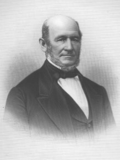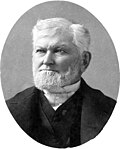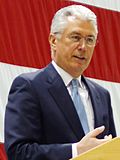What follows is a chronological table that sets out the changes in the composition of the First Presidency of the Church of Jesus Christ of Latter-day Saints (LDS Church) through time. [1]
| Date range | President of the Church (and Assistant Presidents) | First Counselor | Second Counselor | Other Counselors (3C = Third Counselor) C = Counselor AC = Assistant Counselor) | Change from previous organization | ||
|---|---|---|---|---|---|---|---|
| 8 March 1832 – 3 December 1832 | Initial organization of First Presidency [2] | ||||||
| 3 December 1832 – 18 March 1833 | Jesse Gause excommunicated | ||||||
| 18 March 1833 – 5 December 1834 | Sidney Rigdon called as First Counselor; Frederick G. Williams called as Second Counselor | ||||||
| 5 December 1834 – 3 September 1837 | Oliver Cowdery called as Assistant President of the Church | ||||||
| 3 September 1837 – 7 November 1837 | Hyrum Smith, John Smith and Joseph Smith, Sr. called as Assistant Counselors; Oliver Cowdery also given the title of Assistant Counselor | ||||||
| 7 November 1837 – 11 April 1838 | Frederick G. Williams rejected as Second Counselor at church conference; Hyrum Smith called as Second Counselor | ||||||
| 11 April 1838 – 14 September 1840 | Oliver Cowdery excommunicated | ||||||
| 14 September 1840 – 24 January 1841 | John Smith (AC) | Death of Joseph Smith, Sr. | |||||
| 24 January 1841 – 8 April 1841 | Hyrum Smith called as Assistant President of the Church; William Law replaces Hyrum Smith as Second Counselor | ||||||
| 8 April 1841 – 25 May 1842 | John C. Bennett called as Assistant President [3] | ||||||
| 25 May 1842 – 4 February 1843 | John C. Bennett disfellowshipped | ||||||
| 4 February 1843 – 18 April 1844 | Amasa Lyman called as Counselor | ||||||
| 18 April 1844 – 27 June 1844 | Apostasy of William Law | ||||||
| 27 June 1844 – 27 December 1847 | No organized First Presidency: Death of Joseph Smith and Hyrum Smith; dissolution of First Presidency | ||||||
| 27 December 1847 – 11 March 1854 | First Presidency reorganized after deaths of Joseph Smith and Hyrum Smith | ||||||
| 11 March 1854 – 7 April 1854 | Death of Willard Richards | ||||||
| 7 April 1854 – 1 December 1856 | Jedediah M. Grant called as Second Counselor | ||||||
| 1 December 1856 – 4 January 1857 | Death of Jedediah M. Grant | ||||||
| 4 January 1857 – 1 July 1866 | Daniel H. Wells called as Second Counselor | ||||||
| 1 July 1866 – 22 June 1868 | Joseph F. Smith (C) | Joseph F. Smith called as Counselor | |||||
| 22 June 1868 – 7 October 1868 | Death of Heber C. Kimball | ||||||
| 7 October 1868 – 8 April 1873 | George A. Smith called as First Counselor | ||||||
| 8 April 1873 – 9 May 1874 | Joseph F. Smith (C) John Willard Young (C) George Q. Cannon (C) Brigham Young, Jr. (C) Lorenzo Snow (C) Albert Carrington (C) | John Willard Young, George Q. Cannon, Brigham Young, Jr., Lorenzo Snow, and Albert Carrington called as Counselors | |||||
| 9 May 1874 – 1 September 1875 | Joseph F. Smith (C) John Willard Young (AC) George Q. Cannon (AC) Brigham Young, Jr. (AC) Lorenzo Snow (AC) Albert Carrington (AC) | Titles of all additional counselors (except Joseph F. Smith) changed from Counselor to Assistant Counselor | |||||
| 1 September 1875 – 8 October 1876 | Joseph F. Smith (C) John Willard Young (AC) George Q. Cannon (AC) Brigham Young, Jr. (AC) Lorenzo Snow (AC) Albert Carrington (AC) | Death of George A. Smith | |||||
| 8 October 1876 – 29 August 1877 | Joseph F. Smith (C) George Q. Cannon (AC) Brigham Young, Jr. (AC) Lorenzo Snow (AC) Albert Carrington (AC) | John Willard Young called as First Counselor | |||||
| 29 August 1877 – 10 October 1880 | No organized First Presidency; Death of Brigham Young; dissolution of First Presidency | ||||||
| 10 October 1880 – 25 July 1887 | First Presidency reorganized after death of Brigham Young | ||||||
| 25 July 1887 – 7 April 1889 | No organized First Presidency; Death of John Taylor; dissolution of First Presidency | ||||||
| 7 April 1889 – 2 September 1898 | First Presidency reorganized after death of John Taylor | ||||||
| 2 September 1898 – 13 September 1898 | No organized First Presidency; Death of Wilford Woodruff; dissolution of First Presidency | ||||||
| 13 September 1898 – 12 April 1901 | First Presidency reorganized after death of Wilford Woodruff | ||||||
| 12 April 1901 – 6 October 1901 | Death of George Q. Cannon | ||||||
| 6 October 1901 – 10 October 1901 | Joseph F. Smith called as First Counselor; Rudger Clawson called as Second Counselor. NOTE: These counselors were sustained but not set apart due to the death of Snow 4 days later | ||||||
| 10 October 1901 – 17 October 1901 | No organized First Presidency; Death of Lorenzo Snow; dissolution of First Presidency | ||||||
| 17 October 1901 – 27 March 1910 | Reorganization of First Presidency after death of Lorenzo Snow | ||||||
| 27 March 1910 – 7 April 1910 | Death of John R. Winder | ||||||
| 7 April 1910 – 13 October 1911 | Anthon H. Lund called as First Counselor; John Henry Smith called as Second Counselor | ||||||
| 13 October 1911 – 7 December 1911 | Death of John Henry Smith | ||||||
| 7 December 1911 – 19 November 1918 | Charles W. Penrose called as Second Counselor | ||||||
| 19 November 1918 – 23 November 1918 | No organized First Presidency; Death of Joseph F. Smith; dissolution of First Presidency | ||||||
| 23 November 1918 – 2 March 1921 | Reorganization of First Presidency after death of Joseph F. Smith | ||||||
| 2 March 1921 – 10 March 1921 | Death of Anthon H. Lund | ||||||
| 10 March 1921 – 16 May 1925 | Charles W. Penrose called as First Counselor; Anthony W. Ivins called as Second Counselor | ||||||
| 16 May 1925 – 28 May 1925 | Death of Charles W. Penrose | ||||||
| 28 May 1925 – 11 December 1931 | Anthony W. Ivins called as First Counselor; Charles W. Nibley called as Second Counselor | ||||||
| 11 December 1931 – 6 April 1933 | Death of Charles W. Nibley | ||||||
| 6 April 1933 – 23 September 1934 | J. Reuben Clark called as Second Counselor | ||||||
| 23 September 1934 – 11 October 1934 | Death of Anthony W. Ivins | ||||||
| 11 October 1934 – 14 May 1945 | J. Reuben Clark called as First Counselor; David O. McKay called as Second Counselor | ||||||
| 14 May 1945 – 21 May 1945 | No organized First Presidency; Death of Heber J. Grant; dissolution of First Presidency | ||||||
| 21 May 1945 – 4 April 1951 | Reorganization of First Presidency after death of Heber J. Grant | ||||||
| 4 April 1951 – 9 April 1951 | No organized First Presidency; Death of George Albert Smith; dissolution of First Presidency | ||||||
| 9 April 1951 – 19 May 1959 | Reorganization of First Presidency after death of George Albert Smith | ||||||
| 19 May 1959 – 12 June 1959 | Death of Stephen L Richards | ||||||
| 12 June 1959 – 22 June 1961 | J. Reuben Clark called as First Counselor; Henry D. Moyle called as Second Counselor | ||||||
| 22 June 1961 – 6 October 1961 | Hugh B. Brown called as Third Counselor | ||||||
| 6 October 1961 – 12 October 1961 | Death of J. Reuben Clark | ||||||
| 12 October 1961 – 18 September 1963 | Henry D. Moyle called as First Counselor; Hugh B. Brown called as Second Counselor | ||||||
| 18 September 1963 – 4 October 1963 | Death of Henry D. Moyle | ||||||
| 4 October 1963 – 28 October 1965 | Hugh B. Brown called as First Counselor; N. Eldon Tanner called as Second Counselor | ||||||
| 28 October 1965 – 29 October 1965 | Thorpe B. Isaacson called as Counselor | ||||||
| 29 October 1965 – 6 April 1968 | Joseph Fielding Smith called as Counselor | ||||||
| 6 April 1968 – 18 January 1970 | Alvin R. Dyer called as Counselor | ||||||
| 18 January 1970 – 23 January 1970 | No organized First Presidency; Death of David O. McKay; dissolution of First Presidency | ||||||
| 23 January 1970 – 2 July 1972 | Reorganization of First Presidency after death of David O. McKay | ||||||
| 2 July 1972 – 7 July 1972 | No organized First Presidency; Death of Joseph Fielding Smith; dissolution of First Presidency | ||||||
| 7 July 1972 – 26 December 1973 | Reorganization of First Presidency after death of Joseph Fielding Smith | ||||||
| 26 December 1973 – 30 December 1973 | No organized First Presidency; Death of Harold B. Lee; dissolution of First Presidency | ||||||
| 30 December 1973 – 23 July 1981 | Reorganization of First Presidency after death of Harold B. Lee | ||||||
| 23 July 1981 – 27 November 1982 | Gordon B. Hinckley called as Counselor | ||||||
| 27 November 1982 – 2 December 1982 | Death of N. Eldon Tanner | ||||||
| 2 December 1982 – 5 November 1985 | Marion G. Romney called as First Counselor; Gordon B. Hinckley called as Second Counselor | ||||||
| 5 November 1985 – 10 November 1985 | No organized First Presidency; Death of Spencer W. Kimball; dissolution of First Presidency | ||||||
| 10 November 1985 – 30 May 1994 | Reorganization of First Presidency after death of Spencer W. Kimball | ||||||
| 30 May 1994 – 5 June 1994 | No organized First Presidency; Death of Ezra Taft Benson; dissolution of First Presidency | ||||||
| 5 June 1994 – 3 March 1995 | Reorganization of First Presidency after death of Ezra Taft Benson | ||||||
| 3 March 1995 – 12 March 1995 | No organized First Presidency; Death of Howard W. Hunter; dissolution of First Presidency | ||||||
| 12 March 1995 – 10 August 2007 | Reorganization of First Presidency after death of Howard W. Hunter | ||||||
| 10 August 2007 – 6 October 2007 | Death of James E. Faust [4] | ||||||
| 6 October 2007 – 27 January 2008 | Henry B. Eyring called as Second Counselor | ||||||
| 27 January 2008 – 3 February 2008 | No organized First Presidency; Death of Gordon B. Hinckley; dissolution of First Presidency | ||||||
| 3 February 2008 – 2 January 2018 | Reorganization of First Presidency after death of Gordon B. Hinckley [5] | ||||||
| 2 January 2018 – 14 January 2018 | No organized First Presidency; Death of Thomas S. Monson; dissolution of First Presidency | ||||||
| 14 January 2018 – 27 September 2025 | Reorganization of First Presidency after death of Thomas S. Monson [6] | ||||||
| 27 September 2025 – 14 October 2025 | No organized First Presidency; Death of Russell M. Nelson; dissolution of First Presidency | ||||||
| 14 October 2025 – | Reorganization of First Presidency after death of Russell M. Nelson | ||||||






















































